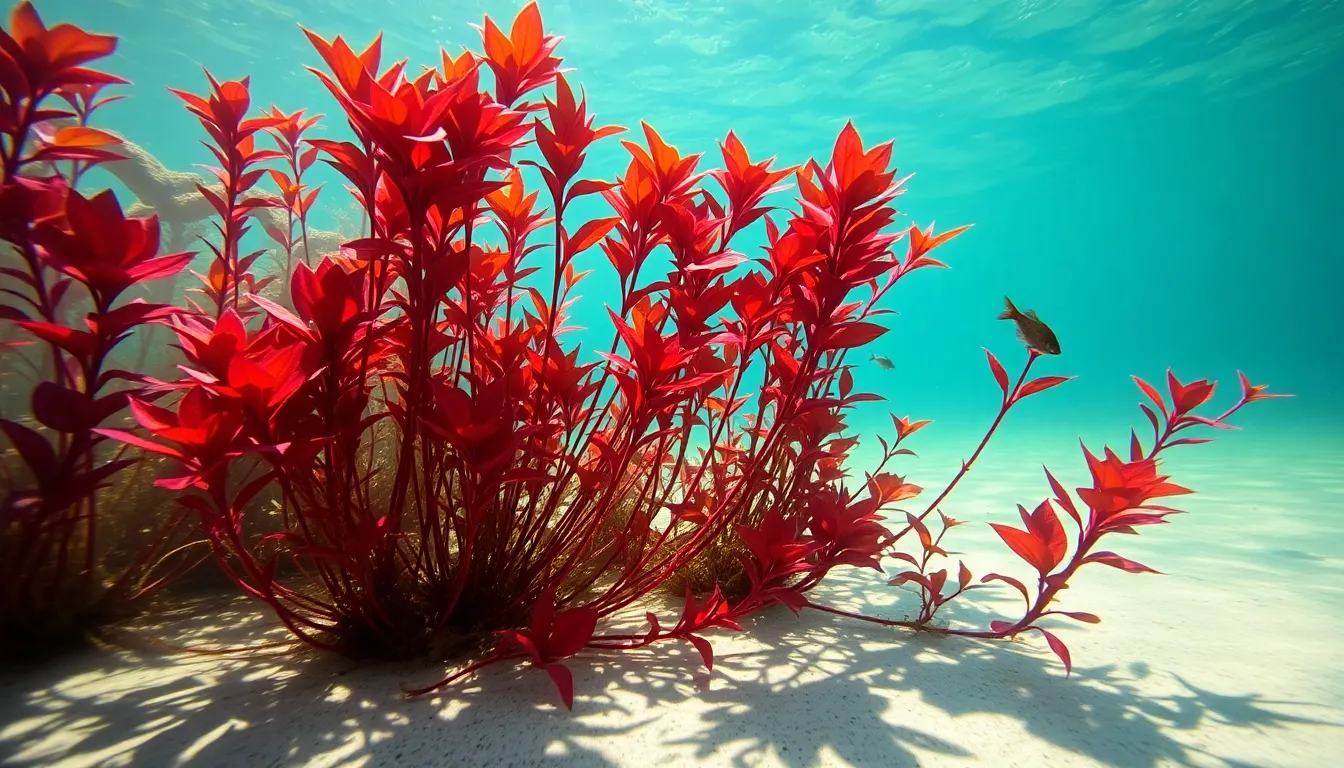Diving into the enchanting world of aquatics can sometimes feel akin to navigating a jungle. Yet, amid that swaying green foliage, red aquatic plants emerge like fiery gems, demanding attention and admiration. These plants don’t just fill a tank: they revolutionize it. From stunning colors to providing essential habitat, red aquatic plants are a must for any aquarium enthusiast. Let’s explore this vibrant world, unraveling their mysteries and understanding why they deserve a prized spot in your underwater oasis.
Red Aquatic Plants

Red aquatic plants are more than visually striking: they play vital roles in the aquatic ecosystem. Plants turn sunlight into energy through photosynthesis, and many red species do so with a vibrant twist. This color often indicates a healthy balance of nutrients and light, showcasing the plant’s vitality.
Also, red pigments, known as anthocyanins, allow these plants to absorb light better in deeper waters where sunlight may be scarce. So, they thrive in diverse aquatic environments, showcasing red hues as a powerful tool for survival. The striking colors not only captivate aquarists but also help these plants outcompete rivals in crowded underwater habitats.
Types of Red Aquatic Plants
Fascination with red aquatic plants is inevitable due to their variety. Here are several popular types:
1. Alternanthera reineckii
Often referred to as “Reineck’s Alternanthera,” this plant flourishes with brilliant red and green leaves. Ideal for mid-ground planting, it can reach heights of 12 inches or more.
2. Ludwigia repens
A true gem, Ludwigia repens boasts leaves turning from green to deep red with adequate light. Its bushy growth pattern makes it perfect for adding depth to aquascapes.
3. Cuphea
While not as commonly known, Cuphea produces stunning red flowers, adding splashes of color plus to its lush foliage. This plant prefers warmer waters and can enhance any aquarium setting.
4. Hygrophila polysperma
Known for its fast growth and vibrant green to pink leaves, it can add a soft contrast against darker substrates. Aquarists appreciate its ability to thrive in various conditions.
5. Bacopa caroliniana
Though it primarily showcases green, Bacopa can exhibit reddish tints when placed under proper lighting conditions. This versatility makes it a favored choice for those seeking dynamic plant life.
The Role of Red Aquatic Plants in Ecosystems
Red aquatic plants contribute significantly to their ecosystems beyond visual appeal. They enhance water quality by absorbing excess nutrients, mitigating the risk of algae blooms. The dense foliage provides shelter for fish and invertebrates, creating a complex habitat that supports biodiversity.
Also, these plants serve as food sources for various aquatic organisms. Species such as snails, shrimp, or certain fish often graze on the leaves, ensuring their thriving in balanced ecosystems. By maintaining an equilibrium, red aquatic plants are pivotal in preserving the health and stability of their environments.
How to Care for Red Aquatic Plants
To nurture red aquatic plants effectively, consider these care tips:
1. Lighting:
These plants typically require higher light levels to thrive and maintain their vibrant colors. Aim for full-spectrum lighting, with a duration of 10-12 hours a day to mimic natural sunlight.
2. Nutrients:
Use substrate fertilizers or liquid fertilizers rich in iron and potassium. Regularly monitor nutrient levels to prevent deficiencies, especially under intense lighting.
3. Pruning:
Trimming these plants encourages bushier growth and prevents overcrowding. Remove any dying leaves promptly to maintain aesthetic appeal and prevent any negative effects on water quality.
4. Water Quality:
Maintain stable parameters: a pH between 6.0 and 7.5 is usually ideal. Weekly water changes can help keep the tank clean and free from harmful buildup. Monitoring levels of ammonia, nitrate, and phosphate is essential.
Benefits of Including Red Aquatic Plants in Aquariums
Adding red aquatic plants offers numerous advantages:
1. Aesthetic Appeal:
The vibrant hues of red plants enhance the visual interest of any aquarium, making them the centerpiece of aquatic décor.
2. Improved Water Quality:
These plants help in oxygenating the water and absorbing harmful toxins, benefiting both flora and fauna within the tank.
3. Habitat for Aquatic Life:
They provide essential shelter for fish and invertebrates, promoting a healthier ecosystem altogether.
4. Natural Filtration:
Such plants contribute to the biological filtration process, helping to balance the nitrogen cycle in the tank and fostering a self-sustaining environment.
Challenges and Considerations
Although red aquatic plants come with a multitude of benefits, they do require diligent care:
1. Light Requirements:
Not all aquarists have access to high-intensity lighting systems. The need for specific lighting may deter some from keeping these beautiful plants.
2. Nutrient Needs:
Balanced nutrient supplementation is crucial. Over-fertilization can lead to algae issues while under-fertilization can cause leaf loss and color fading.
3. Compatibility:
Some fish may graze on delicate red plants, potentially leading to damage. It’s vital to consider the inhabitants of the aquarium when selecting plants.
4. Pest Presence:
These plants can sometimes attract pests or suffer from diseases. Regular inspections and swift action can help maintain plant health.

